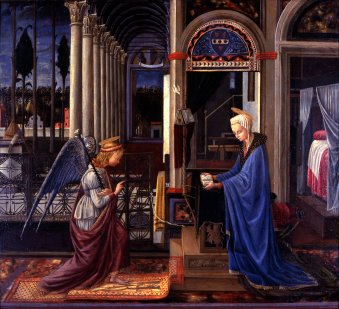
|
|
|
|
|
|
|

|

|

|

|

|

|
|
You are here: Home > Culture & Arts |
| Art & Museums |
| Theatre & Film |
| Literature & Poetry |
| Photography & Auctions |
| Dance & Music |
| Festivals & Culture |
| History |
| |
| Help | Site Map |
| |
| |
| |
| About Us |
| Sponsors |
| Recommend the Site |
| SWW Gift Shop |
| Letters |
| Feedback |
|
Think Renaissance greats and think Michelangelo, Leonardo, Filippo Lippi, Mantegna, Luca della Robbia and Piero della Francesca, to name a few. Mention Fra Carnevale, an artist from Urbino who joined Filippo Lippi’s workshop in Florence and later became a Dominican friar, and the reaction is pretty muted. But this little-known creative genius, long a mystery figure even to scholars, takes center stage at a new exhibit at The Metropolitan Museum of Art in New York, From Filippo Lippi to Piero della Francesca: Fra Carnevale and the Making of a Renaissance Master, now through May 1, 2005. As curator of European Paintings Keith Christiansen remarked at a preview for the press, "This peripheral character [is] central to our understanding of the Renaissance,” and to Renaissance painting in the Marches (a mountainous area located between the Apennines and the Adriatic) in particular. Archival work undertaken for the exhibition has redefined our concept of Fra Carnevale, Christiansen explained, and led to his positive identification as the artist who painted the famed Barberini Panels, the two lateral elements of an altarpiece which are on display at The Met — The Birth of the Virgin (1466) and The Presentation of the Virgin in the Temple (?) (1466) — and comprise the show’s centerpiece. Born Bartolomeo di Giovanni Corradini in Urbino in 1420 and nicknamed Fra Carnevale (Brother Lent) upon joining a Dominican order in 1449, this paradigmatic Renaissance painter emerges from the shadows at The Met and forms the narrative thread of an exhibition consisting of some 50 Renaissance works. Known principally from Giorgio Vasari’s Lives of the Artists as a painter who influenced the architect Bramante, he becomes at The Met a painter who brought Florentine — i.e., Renaissance — ideas to Urbino and eluded textbook writers. As an assistant in Filippo Lippi’s workshop, the place to study in the 15th century, Carnevale painted on Lippi’s altarpieces, studied the works of the city’s artists, and learned from the master, dubbed the greatest artist of his age by Vasari. Other seminal influences that Carnevale gleaned from the 15th-century’s creative nexus in Florence (the equivalent of Paris in the 1920s) included exposure to the works of Domenico Veneziano, best known for his Saint Lucy Altarpiece, parts of which are on display in the exhibit. Carnevale was profoundly influenced by the architecture he saw in Florence and derived considerable inspiration from Leon Battista Alberti. The great theorist of Renaissance architecture frequented the court of Urbino and believed there was no distinction between sculpture and painting. Carnevale took his ideas to heart, creating paintings that were perhaps most notable for their architectural elements. The Annunciation (1445-1450) illustrated above, which scholars now believe can be attributed to Carnevale because of its integration of elaborate architectural features and intriguing perspective, is a case in point. Painted for Jacques Coeur, finance minister of King Charles VII and the richest man in France, The Annunciation is riddled with interior spaces and architecture that is reminiscent of Michelozzo Michelozzi, architect to the Medicis. It boasts grillwork that recalls the Florentine sculptor and bronze founder Maso di Barolomeo and is replete with Marian symbols. As a sop to its patron, a merchant with investments in the eastern Mediterranean, the scene is graced with a slender oriental rug upon which the angel genuflects. But the show at The Met deserves special credit for reuniting the two surviving panels from Carnevale’s masterpiece, an altarpiece (1466-67) executed for the oratory of Urbino's Santa Maria della Bella, a church which no longer exists. The paintings, purchased in the 1930s by The Met and the Boston Museum of Fine Arts from the Barberini Collection in Rome, are remarkable for their architecture, their secular, genrelike elements and their understated portrayal of their main subjects. For instance, in The Birth of the Virgin the Virgin appears as a tiny background figure. As the curator notes, “In no comparable Renaissance paintings have the religious themes been used as a point of departure for the study of architecture and the suggestion of everyday life.” Indeed, beggars sprawled across the foreground in The Presentation of the Virgin in the Temple (?) impart a vivid realism. The panels are regarded as prime examples of the artist’s ingenuity and sense of invention. Carnevale’s taste for architecture was not only reflected in his paintings. He actually plotted works of architecture, providing designs to the stonemasons of the Palazzo Ducale in Urbino, thought by some to be the most beautiful early Renaissance secular structure. He also collaborated on the construction of a portal for the church of San Domenico, Urbino’s first Renaissance monument, in addition to designing capitals for the city’s cathedral. “He wanted to be a Renaissance master in Urbino,” Curator Keith Christiansen exclaimed. He became, instead, a master for the ages. Val Castronovo covers exhibitions and arts-related stories for the UN Chronicle and Secretariat News at the United Nations. She is a former reporter for TIME Magazine, where she worked for 21 years. A native New Yorker and Vassar grad, she lives in Manhattan with her husband and their daughter, Olivia. |
|
|
